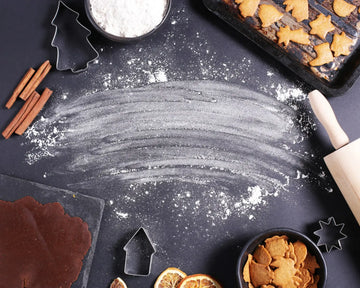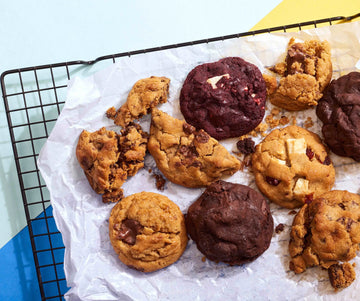Baking is a science, and like all sciences, it requires precision and accuracy. The slightest mistake can completely ruin your baking projects – from undercooked loaves of bread to dry cakes or lopsided cupcakes.
Whether you’re a beginner baker or a seasoned pro, we all make mistakes in the kitchen. But with the right knowledge, you can avoid these common baking blunders and turn out delicious treats with ease.
In this blog post, we’ll cover 10 common baking mistakes that you should avoid in order to create delicious confections every time!
Common Baking Mistakes
1. Not pre-heating the oven
One of the most common baking mistakes is not pre-heating the oven. This can result in uneven cooking, as well as a longer total bake time. To avoid this mistake, be sure to set your oven to the correct temperature and allow it to pre-heat for at least 10 minutes before placing your food inside.
2. Forgot to add the key ingredient
If you’re in the middle of baking and realise you’ve forgotten to add a key ingredient, don’t panic! There are a few things you can do to salvage your dish.
If the ingredient you forgot is dry, like flour or baking powder, you can try adding it to the dish and hope that it will still turn out okay. If the ingredient is wet, like milk or eggs, you’ll need to be a little more creative.
One option is to mix together a replacement for the wet ingredient. For milk, you could mix together water and powdered milk. For eggs, you could use a flax egg or chia egg. These substitutions may not work for all recipes, but they’re worth a try!
Another option is to start from scratch with a new batch of batter or dough. This may not be ideal if you’re short on time or ingredients, but it’s always better to have a dish that tastes good than one that’s only half-baked (literally).
3. Not measuring your ingredients
One of the most common baking mistakes is not measuring your ingredients. This can lead to recipes that are either too dry or too wet and can ruin the texture and flavor of your baked goods. Make sure to measure all of your ingredients accurately before you begin baking.
Also Read: Heavy Cream vs. Whipped Cream vs. Fresh Cream
4. Opening the oven too often
Opening the oven door too often can let out all the heat, making it harder for your food to cook correctly. When checking on your food, try to resist the urge to open the door too often. Instead, peek through the window if possible.
5. The cake is too wet or too dry
There are a few possible reasons why your cake might be too wet or too dry. Maybe you didn’t measure the ingredients correctly, or maybe you didn’t bake it for long enough. Whatever the reason, there are a few things you can do to fix the problem.
If your cake is too wet, you can try putting it back in the oven for a few minutes. If that doesn’t work, you can try adding some bread crumbs or flour to absorb some of the moisture. If your cake is too dry, you can try adding some milk or water to it. You can also try covering it with a damp cloth while it’s cooling to help it retain moisture.
Whatever the problem is, there’s likely a solution. With a little trial and error, you’ll be able to figure out what works best for your cake.
6. Using ingredients at the wrong temperature
One of the most common baking mistakes is using ingredients that are either too cold or too hot. Room-temperature ingredients are typically best for baking, so if your recipe calls for butter, eggs, or milk at room temperature, make sure to set them out ahead of time. If you’re short on time, you can also microwave cold butter for 20-30 seconds until it’s soft enough to cream.
If your recipe calls for melted chocolate or hot coffee, make sure not to let the liquid cool too much before adding it to your batter. Otherwise, it will seize up and be difficult to incorporate.
7. Products not baking evenly
There are a few possible reasons why your products are not baking evenly. One reason could be that you have not preheated your oven properly. Always preheat your oven according to the recipe instructions before baking. Another reason could be that you are opening the door of the oven too often while baking, which can cause fluctuations in temperature and result in uneven baking. Try to resist the temptation of checking on your products too frequently, and only open the door when absolutely necessary. Finally, make sure that you are placing your baking pan in the centre of the oven so that heat is evenly distributed.
8. Cakes baking without flat top
If you’ve ever baked a cake that came out with a domed or sunken top, you know how frustrating it can be. Whether your cake is for a special occasion or just because, no one wants a less-than-perfect result. Avoid these common baking mistakes to help ensure your cakes turn out beautifully every time.
- Cakes baking without flat top: One of the most common causes of cakes with domed or sunken tops is over-mixing the batter. Over-mixing incorporates too much air into the batter, which causes the cake to rise unevenly and creates an undesirable texture. Be sure to mix the batter just until the ingredients are combined; don’t overdo it!
- Adding too much leavener: Another common mistake is adding too much leavener, such as baking powder or soda. This can cause the cake to collapse when it comes out of the oven, resulting in a sunken top. When measuring leavener, be precise and use only the amount called for in the recipe.
- Opening the oven door frequently: Every time you open the oven door while cake is baking, heat escapes and can cause the cake to become overcooked on the outside and gooey in the middle. If possible, resist opening the door until it’s time to check on whether the cake is done.
Also Read: Baking Powder vs. Baking Soda
9. Cookies are not getting flat
One of the most common baking mistakes is not getting your cookies flat. This can happen for a number of reasons, but the most common one is using too much flour. When you use too much flour, the cookies will not spread out and will be dense and cakey. Another reason why your cookies might not be getting flat is that you’re not using enough butter. The butter helps to flatten out the cookies and gives them a more consistent texture. Finally, make sure you’re baking the cookies at the right temperature. If they’re too cold, they won’t spread out, and if they’re too hot, they’ll burn.
10. Dough taking an odd texture
If you’ve ever had dough that’s taken on an odd, crumbly texture, it’s likely because you’ve made one of these common baking mistakes. Over-mixing the dough is a common culprit, as is using too much flour. Other times, the problem can be with the recipe itself. If you’re using a recipe that calls for self-rising flour, make sure to read the instructions carefully. Self-rising flour already contains baking powder and salt, so you’ll need to adjust the amount of those ingredients called for in the recipe.
Conclusion
Baking can be a daunting task, especially for beginners, but with the right techniques and strategies, you can make your baked goods come out perfectly every time. We hope that our list of 10 common baking mistakes has been useful to you and will help you on your way to becoming a master baker! With these tips in mind, plus practice and experimentation, anyone can become an expert in the kitchen. So let’s get baking!







